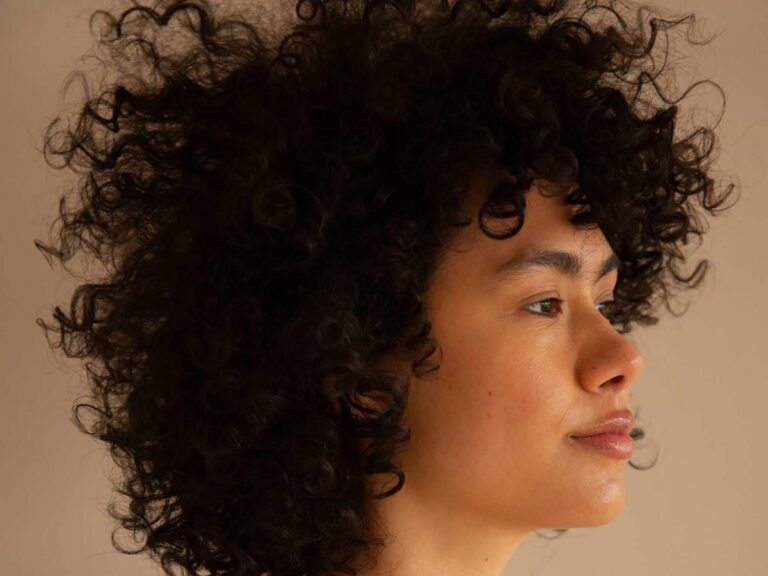Simply put, it takes longer to grow out curly hair than straight hair because curly hair twists and turns, so the hair growth isn’t as visible as with straight hair. Also, curly hair is more prone to breakage, so even if you do manage to grow your curls out, they won’t stay that way forever.
To get to the bottom of how to grow out curly hair, we spoke to two natural hair care experts, Annajid “Kee” Taylor and Darrius Peace. Read on for tips and tricks to keep your curly hair healthy, prevent breakage, and grow it out.
Meet Our Experts
Moisturize frequently
Breakage can stunt hair growth, and to prevent that, moisturizing is key. “Keeping curly hair well moisturized is essential to preventing breakage,” explains Taylor. “Regular deep conditioning treatments will help retain moisture and strengthen your hair.” Peace agrees, saying, “Conditioning frequently and using little to no heat treatments can also help[prevent]breakage.”
Detangling Properly
The need to detangle curly hair is inevitable, but how, when, and what you use are crucial. Peace says that when it comes to detangling and encouraging hair growth, the winning trio is water, conditioner, and a detangling brush, and Taylor agrees: “These tools are designed to smooth out and move hair while minimizing breakage and pulling,” she says.
“Wetting your hair and saturating it with conditioner will make it slippery and easier to detangle,” says Taylor, and “starting with the ends and working your way up to the roots will help prevent breakage and reduce stress.”
Stay hydrated
Moisture coats and protects the outside of your hair, while hydration keeps the inside of your hair from drying out. Both are important for promoting hair growth and preventing breakage, and you can find products that do both. “Applying a creamy conditioner to wet hair is the most ideal way to retain hydration and moisture,” advises Peace.
Trim regularly
Cutting your hair to grow it may seem counterintuitive, but it’s true that you do need a trim every now and then. It helps indirectly. “Trimming doesn’t help hair growth, but it does give it a nice finish and makes it easier to comb and brush,” explains Peace. And easier to comb and brush means new hair growth is better maintained. Plus, “trimming removes split ends, which helps prevent breakage and damage from spreading up the hair shaft,” adds Taylor. “This helps maintain hair length, making it look fuller and healthier, and helping hair growth look better over time.”
Don’t forget your diet
“The food you put in your mouth is what has the most effect on hair growth,” Peace says. “Most topical treatments will help maintain hair growth.” He adds that a variety of deficiencies, such as protein, fresh produce, and adequate hydration, can impede hair growth.
“Hair needs certain nutrients to grow strong and healthy, including proteins that are essential for the production of keratin,” Taylor explains. “Vitamins A, C, and E support scalp health and blood circulation, while biotin is essential for hair loss. Including these vitamins and nutrients in your diet, along with staying hydrated, can go a long way in improving hair health and growth.”
Oil Up
Most people with curly hair are familiar with hair oils that add shine and smoothness to their locks. But some actually help hair grow! Taylor is particularly fond of castor oil and rosemary oil. “Castor oil is rich in fatty acids and vitamin E, which strengthens hair and promotes healthy growth. I especially use Jamaican black castor oil for protective styles to promote hydration and overall hair health.” As for rosemary oil, she says it “increases circulation to the scalp, encouraging hair growth and reducing hair loss.”
Peace says that cooking oils that you have in your kitchen cupboard can also help: “Olive oil and grapeseed oil are great products for maintaining hair growth,” he says.
gently
No matter what tools and techniques you use on your hair, it’s important to remember to be gentle: “Curly hair is dry and brittle, which means it’s more prone to breakage,” says Taylor.
Hair is most vulnerable when it’s wet, so it requires extra care when you treat it. Develop healthy habits that will help you take it easy on your curls. For example, Taylor suggests detangling your hair from the ends up, instead of starting from the top like you would with straight hair.
Protect, protect, protect
Curly hair can benefit from protection: “Protective styles like braids and twists can minimise friction and reduce breakage,” says Taylor, adding, “Sleeping with a silk or satin pillowcase or bonnet can also help.” It’s also important to avoid heat styling where possible, and when that’s not possible, use a heat protectant and dry your hair with a microfiber towel.
Final conclusion
Curly hair growth requires a multi-pronged approach: keeping your hair well protected, moisturized and hydrated, getting the right nutrients to promote hair growth, and being gentle with your tools, products, and care. Because curly hair is prone to bending, it may take longer to see growth, but it will happen. The more you prevent breakage with tips from our stylists, the sooner you’ll see the results you desire.
Read the original article on Byrdie.

